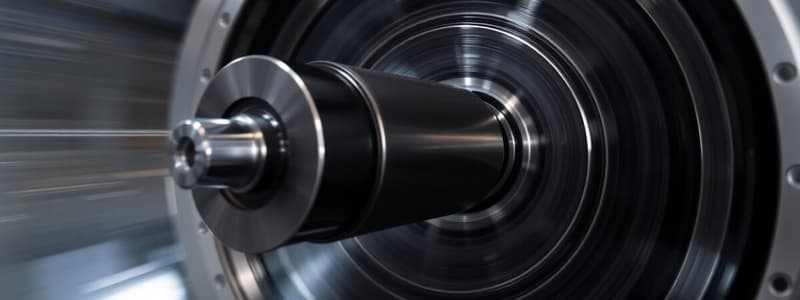Podcast
Questions and Answers
What is translational motion primarily characterized by?
What is translational motion primarily characterized by?
- Change in state with respect to surroundings (correct)
- Rotation around an axis of rotation
- Movement around a pivot point
- Application of force at a distance
What is the moment of force mathematically defined as?
What is the moment of force mathematically defined as?
- The product of force and distance from the axis of rotation (correct)
- The sum of the forces applied
- The difference between clockwise and anticlockwise forces
- The ratio of force to distance
Which of the following is NOT a factor affecting the moment of force?
Which of the following is NOT a factor affecting the moment of force?
- Speed of the moving body (correct)
- Magnitude of force applied
- Sense of rotation
- Distance from the axis of rotation
When a body rotates clockwise, how does the torque act?
When a body rotates clockwise, how does the torque act?
What are two equal and antiparallel forces known as in terms of rotational motion?
What are two equal and antiparallel forces known as in terms of rotational motion?
What is the purpose of a couple in mechanics?
What is the purpose of a couple in mechanics?
Which of the following statements about torque is correct?
Which of the following statements about torque is correct?
How does distance from the pivot affect the force needed to turn an object?
How does distance from the pivot affect the force needed to turn an object?
Which of the following devices is designed to maximize torque by having a long handle?
Which of the following devices is designed to maximize torque by having a long handle?
In which measurement system is torque expressed in kgf × m?
In which measurement system is torque expressed in kgf × m?
Flashcards are hidden until you start studying
Study Notes
Motion
- A body is in motion when it changes its position relative to its surroundings.
- Translational motion occurs when a body moves along a straight line in the direction of the applied force.
- Rotational motion occurs when a force is applied at a distance from the axis of rotation, causing the body to rotate around a fixed point.
Moment of Force (Torque)
- A force applied at a distance from the axis of rotation creates a turning effect known as the moment of force or torque.
- The magnitude of the moment of force depends on the force's magnitude and its perpendicular distance from the axis of rotation.
- The direction of torque is determined by the sense of rotation (clockwise or anticlockwise).
Factors Affecting Moment of Force
- Magnitude of the applied force.
- Distance from the axis of rotation to the line of action of the force.
- Direction of rotation (clockwise or anticlockwise).
Mathematical Representation of Moment of Force
- Moment of force = Force × Perpendicular distance from the axis of rotation (r × F)
Units of Moment of Force
- SI System: Newton-meter (N⋅m)
- CGS System: Dyne-centimeter (Dyn⋅cm)
Examples of Turning Effect
- Opening or shutting a door: The force needed is inversely proportional to the distance from the hinge.
- Turning heavy vehicles (trucks): Larger steering wheels provide greater torque.
- Upper circular stone of a turning wheel: Long handles maximize torque.
- A spanner with a long handle: Maximizes torque for loosening or tightening nuts.
Couple
- Two equal and opposite forces acting on a body at a distance form a couple.
- Couples are used when large turning effects are required.
Equilibrium
- A body is in equilibrium when the net effect of forces acting on it results in no change in its state of motion.
- Static Equilibrium: The body remains at rest, forces are balanced.
- Dynamic Equilibrium: The body is in motion, but its velocity and acceleration remain constant, forces are also balanced.
Moment of a Force (Torque)
- The turning effect of a force about a point is called the moment of the force.
- The magnitude of the moment of force is calculated by multiplying the force and the perpendicular distance from the point to the line of action of the force.
Moment of a Couple
- A pair of equal and opposite forces acting on a body at different points produce rotation.
- The total moment of a couple equals one force multiplied by the perpendicular distance between the lines of action of the forces (couple arm).
Mathematical Expression of Moment of Force:
- Moment of force (F) about point (O) = F × (Perpendicular distance)
Principle of Moments
- For a body to be in equilibrium, the sum of the clockwise moments about any point must equal the sum of the anticlockwise moments about that same point.
Conditions for Equilibrium
- The vector sum of all forces acting on the body must be zero.
- The algebraic sum of the moments of forces about any point of rotation must be zero. This means the sum of clockwise moments equals the sum of anticlockwise moments.
Studying That Suits You
Use AI to generate personalized quizzes and flashcards to suit your learning preferences.




